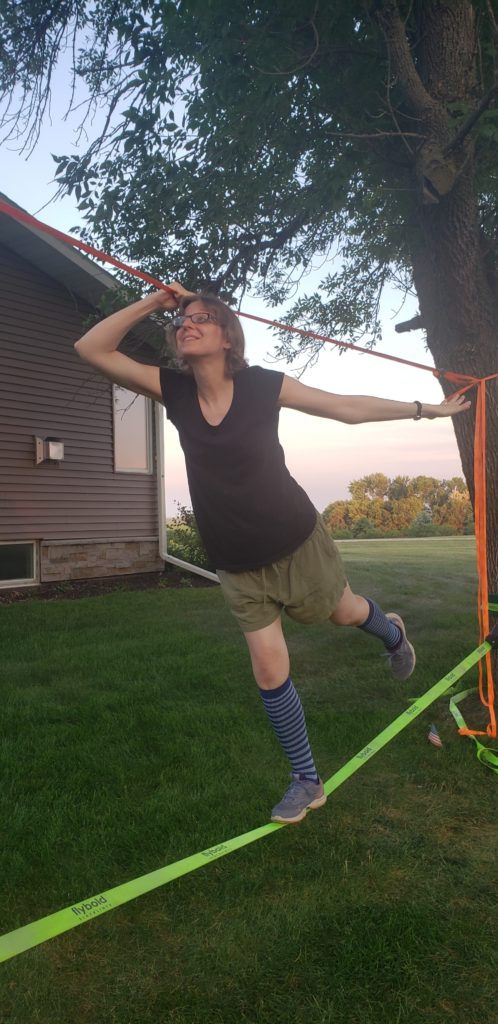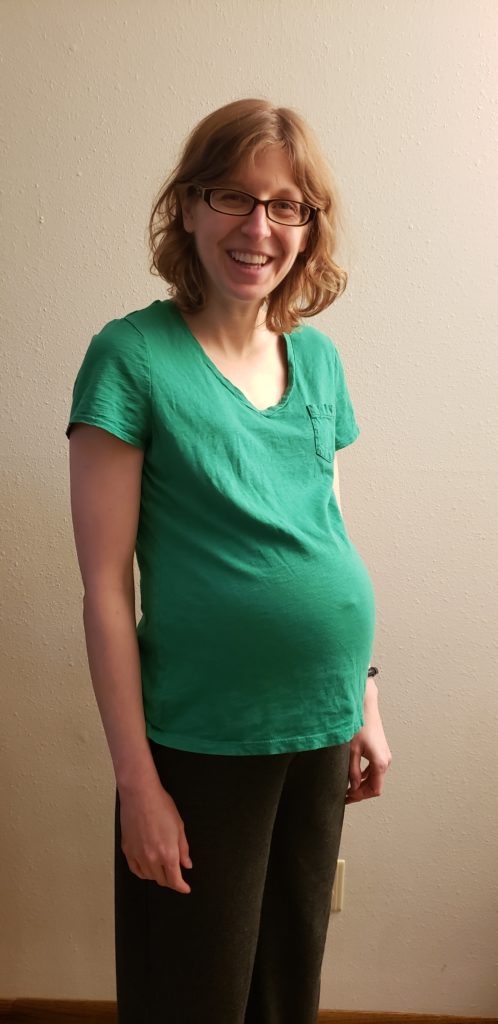Which Kind of Pregnant Woman Are You?
There are two general approaches to pregnancy. Some women want to hear all the horror stories. They want to hear about how your friend’s placenta detached too early, or had a twenty-week ultrasound that showed severe developmental abnormalities. They look up photos of stillborn babies with unpronounceable syndromes, and analyze miscarriage statistics with the intensity of a gambler poring over thoroughbred statistics.
Other women focus on not psyching themselves out. They look up photos of healthy newborns swaddled in hospital blankets, and try not to learn the names of any new genetic disorders. They trust the hospital staff to look out for any signs of trouble, and want to be reassured when there are none. They do not want to hear about how your cousin got gestational diabetes, or went into labor at 32 weeks, or ended up with a fourth-degree vaginal tear.
I wanted to share my pregnancy story because, when I saw the double pink line emerge on my pregnancy test, I didn’t know of any other women who had gone through the ordeal without being able to sit down. And although I devoured pregnancy stories, I didn’t find any that seemed like a suitable reference point.
In telling my story, I decided to prioritize honesty over reassurance. So if you are a pregnant woman in team Don’t Psych Me Out, you may want to stop reading and look elsewhere.
Tl;dr: I did not care for pregnancy. Especially not with sciatica and a sitting disability. But I did like the prize at the end.
Pregnant Makes Me Stpuid
I started off on the wrong foot. Actually, I started off on no feet, since I could barely get out of bed. The day I took the test, I realized that my crushing fatigue and generalized feeling of crappiness was not due to my recent coronavirus vaccination, but was instead a symptom of pregnancy.
The fatigue, which is fairly common among pregnant women in general, was most intense during my first trimester, though it would continue throughout my pregnancy. On many days, I felt like my bed was exerting its own gravitational pull.
The intense grogginess was mental as well as physical. My brain always hovered in the twilight between sleep and wakefulness. Sometimes, I would lie there and stare at the ceiling, unable to muster the motivation even to pick up a book from my nightstand. I couldn’t read anything more difficult than light novels. I would try to watch TV, and would promptly lose track of the plot. I’m getting stupider, I thought.
This fatigue was, as the pregnancy books warned, at its worst during my first trimester. But despite the books’ sunny assertions that I would feel my energy restored after three months, I found that while the fatigue waxed and waned, but it never really went away. Right up until delivery, I was often overcome by a bone-deep exhaustion and mental fog that were out of proportion with anything I’d done that day.
I pictured myself as one of those incubator pods in The Matrix. I was just a piece of equipment. I didn’t need to move, and didn’t even really need a brain. In fact, it was best if I just stopped doing anything beyond maintaining a heartbeat and proper core temperature so I wouldn’t mess up the fetus.
The only subjects that could reliably capture my attention were those that involved babies. In between naps, I spent my time looking up miscarriage statistics and the odds of conceiving a child with various chromosomal abnormalities.
Unfortunately, though, my sciatic nerve still had the power to control me. And although I resisted, the persistent twitching and cramping in my legs would eventually force me out of bed and compel me to walk.
My husband and I were staying with family in rural North Dakota. Though it was technically spring, winter had yet to fully depart, and the spring brought its own style of brutality. The spring winds were deafening. They drowned out the sound of my audiobooks and made me question whether the world was, in fact, quieter before the invention of traffic.
I walked for hours on gravel roads, with the remnants of last year’s corn harvest on either side. Occasionally, a passing car would stop, and the driver would ask if I needed a ride. We both understood that I would not be out walking in this weather if I had a choice.
The icy wind made my nose run, and forced frozen shards of snot right into my pores. I hate this, I thought, as I turned my face into particularly vicious blast. I hate this, I hate this, I hate this. I went into the ditches to pee, and concocted elaborate fantasies about sleeping in the snow-filled culverts.
Let Me Eat Cheesecake
The one pregnancy symptom I never got was the one I assumed was inevitable: morning sickness. I never restricted myself to saltines and candied ginger. I never threw up, and, with the strange exception of my dad’s toasted Bagel Thins, I never developed any weird food aversions.
Instead, I started craving foods I barely knew existed. For a few days, I had an intense yearning for anchovies, even though I had never eaten an anchovy and I’d been a vegetarian for the last ten years. My pregnant brain demanded sesame sticks, and Chex Mix, and ramen, and cheesecake, and anything smothered in enchilada sauce.

Pregnancy is Just Swell
In late spring, just as I was rounding the corner into my second trimester, I noticed that my shoes didn’t fit as well as they used to, and my knees and ankles didn’t bend as far as they should. A few pokes of my fat feet confirmed that I had developed edema again.
I knew my edema was linked to my sitting disability. It flared up again every summer. But usually, I could keep things in check by lying down as much as possible, and wearing compression socks. Now, though, my edema was impervious to these measures. My bloated legs looked as though they had been grafted on from another body.
The truly irritating thing about my edema was the way it was treated by medical professionals. At every pre- and post-partum visit, some health care worker would ask me if I had noticed any swelling in my limbs, which of course I had. But once they wrapped a blood pressure cuff around my arm and got a normal reading, they lost interest.
I soon realized that no one really cared about edema. They cared about preeclampsia, which is often accompanied by swelling.
In the hospital after delivery, I got tired of answering questions about swelling every few hours (I had bare legs and an obvious case of sausage-leg) and asked the nurse directly, “Do you care about swelling if it’s not a sign of preeclampsia?” She only hesitated a half-second before answering, “No.”
But while my swollen legs were not a harbinger of death or an emergency induction, they were a terrible inconvenience. My legs always felt uncomfortably full, and my stretched-out skin was red and painful. I couldn’t bend my knees enough to tie my shoes, which didn’t matter that much, because I couldn’t cram my swollen feet into my hiking boots anyway.
I put up enough of a fuss that the midwives who oversaw my pregnancy eventually wrote me a prescription for medical-grade compression stockings.
At first, I hated my stockings. They were ugly and (I assumed) insufficient. Plus, they were so tight that I had trouble putting them on by myself, especially since I was working around an expanding belly. I had to recruit my husband to help. By the time the stockings were hiked up to my knees, we would both be panting and sweaty.
But after a few weeks, I got over my reservations. I learned to wriggle into my socks without assistance. I admitted that, although the dull beige stockings made me look like an old lady in nylons, at least I looked like an old lady with normal-sized feet. The thigh-high stockings in particular restored an adequate range of motion.
My circulation suffered in other ways. Even before I got pregnant, I assumed I was fated to develop varicose veins, and so I wasn’t surprised when they appeared. I didn’t mind the cosmetic damage, especially since my compression socks covered them anyway, but they were yet another annoying source of pain. I cringed my way through the persistent sensation that I was being stabbed repeatedly in the legs.
I Can’t Take This Lying Down
So far, everything I had experienced could be listed in an obstetrics textbook under the heading, “MINOR DISCOMFORTS OF PREGNANCY.” “Minor,” in medical speak, is code for “Things We Can’t Treat.”
But around week twenty, things changed, and I realized that the source of my sitting disability was going to be affected by pregnancy in wholly unpleasant ways.
Over the course of about a week, my nights got significantly less restful. My cramps came earlier, and got more persistent. At first, I attributed this to the hot weather, but no amount of air conditioning or ingested saltwater seemed to make a difference.
After some experimentation, I realized that the aggravating activity was…lying down. Specifically, lying down on my back. I had lost the ability to lie down on my sides years earlier, so I wasn’t surprised to find those positions were still uncomfortable.
I have particularly vivid memories of a night in Fargo, where I often stayed at my Grandmother’s house, when I gave up on sleep at about 1:30 a.m., and decided to walk down a deserted 32nd Avenue. I slipped past my sleeping husband. If I woke him, I knew that his anxiety would keep him awake until I was safely returned.
Although 32nd is one of Fargo’s main thoroughfares, at this hour, all the businesses were dark, and the lonely cars had three lanes to themselves. I walked from 15th to 45th Street before turning around.
As I passed under the highway, the electric zaps of my sciatic nerve were joined by the intense stabbing pains of my varicose veins. I hate this, I repeated, and realized this phrase was becoming my pregnancy mantra. I hate this, I hate this, I hate this.
This was not my only walk through the wee hours of the night, but it didn’t take many repetitions before I realized it was unsustainable. The only feasible option I could see was to train myself to become a stomach sleeper. Which did not otherwise seem like a good idea in mid-pregnancy.
At first, I was able to artfully arrange pillows under myself to compensate for my growing stomach. But as my belly expanded from cantaloupe to watermelon, I needed extra support. I placed an order for a Cozy Bump inflatable cushion through Amazon. It looked like an oddly-shaped pool float with a hole cut out of it. It’s one of those products that looks comically unnecessary until you actually need it.
While the Cozy Bump was better than nothing, I still missed lying on my back. At least on my back, I could read, or write, or use my computer. But I never did find a way to do any of these things comfortably on my stomach.
I spent most of my remaining pregnancy on my feet. I thought often of Leto, the character from Greek mythology who was compelled to wander the land, looking for a spot of earth that would let her deliver her twins.

When It Comes to Ligaments, There’s Such a Thing as Too Relaxed
I suffered other aches and pains, of course. Most were minor, or at least transitory, and in a normal pregnancy they might have been nothing more than comedic episodes.
I got lightheaded, and learned to grab onto the dresser beside my bed for a minute after I stood up while I waited for my circulation to catch up. I got winded by the slightest exertion, and had to stop and catch my breath on the most leisurely of walks.
The swelling reached my eyes, and suddenly my vision wasn’t quite what it had been, and it hadn’t been very good in the best of times. I couldn’t read restaurant menus or street signs, and most printed books were rendered inaccessible.
My ribcage stretched, which is something I had not been conscious of before. I spent about a week feeling like I had razor blades stuck between my ribs. I did my best not to cough, sneeze, or even breathe too heavily.
The ligaments in my knees were another casualty. Thanks to my new hormonal friend relaxin, they loosened, and suddenly my left kneecap was popping out of place on a daily basis. This wasn’t exactly a new problem. I’d been dealing with a dislocating patella since junior high. As an adult, I learned that squats and lunges did wonders to keep these incidents to a minimum, but now, no amount of exercise seemed sufficient.
With each dislocation, the pain was intense, but it usually receded quickly once I popped my kneecap back into place. The part that I found truly upsetting was how these incidents – which were always entirely unpredictable – set me up for a fall. (In case it isn’t obvious, it’s impossible to walk with a kneecap out of place.)
I would be heading outside for a walk, or going down the stairs, or reaching for a tool in the garage, and whack! My kneecap would slide off at some odd angle to the left of where it should be.
Once, I dropped a full bowl of oatmeal down the stairs. I was in a foul mood as I limped upstairs to get a bucket of water to clean it up, but I was also terrified of what might happen to the baby next time if I couldn’t catch the railing. I started wearing a knee brace, doing daily squats, and taking the stairs as carefully as possible.
At 37 weeks, my sacroiliac joint decided that it, too, wanted to stretch itself out. This was another joint that I preferred to keep locked stiffly in place.
Unfortunately, this particular pain took weeks to resolve, and worked against my sciatica. My sciatic nerve compelled me to walk constantly. Staying still was often intolerable. But movement of any sort, especially walking, aggravated my sacroiliac joint and made me feel like my hips were splitting apart.
I spent the last few weeks of my pregnancy in a state of damned-if-I-do, damned-if-I-don’t. I couldn’t really walk, but I also couldn’t not walk. So I ended up hobbling on my treadmill for hours a day. I kept a slow pace, often not exceeding 1.5 miles per hour. With my tottering, lopsided gait, I looked like I was auditioning for a zombie movie.
Until my hips rebelled, I had faithfully kept up with my daily Big 3 exercises. But the side plank made my hip feel like it was being ripped apart, and so I let myself flake out for the remainder of my pregnancy.
As my due date approached and then passed, I felt myself becoming less and less human, and more and more animal. I was driven by pain, unable to sit, and now unable to lie down for more than an hour or two at a time. My pregnancy fatigue never really abated, and I wanted nothing more than to collapse and sleep until my child was old enough to start school.
I spent all day, every day on my feet. I would walk between ten and thirteen miles on my treadmill, and do whatever weightlifting exercises I could manage. I spent the rest of my time cooking and cleaning. These domestic tasks were the perfect outlet for my restlessness and short attention span. I acquired a sourdough starter through a Facebook group, and sorted and re-sorted piles of baby clothes.
One Good Thing
In one regard, I was incredibly fortunate. My husband was, and always has been, incredibly understanding of my shortcomings. He never demanded that I do more than I was capable of, and he spent endless hours listening to me complain about my latest pregnancy ailment.
He drove me to every doctor’s appointment, and asked the questions that I was too proud or embarrassed to bring up. When I got too tired to continue my outdoor walks, he would come pick me up.
My family, too, was more accommodating than I had any right to expect. I always rode shotgun in my nest of pillows, and they got a cot for me to put in the living room. My Mom refused to let me do the dishes, since bending over aggravated my sciatica further, and she insisted I get a treadmill desk before winter set in.
No Pregnancy Lasts Forever
No pregnancy lasts forever, but as my due date receded farther and farther into the past, I realized my baby was trying to test the limits of the possible. Eventually, her arrival was hastened with a dose of Pitocin, and it was time to take on the next challenge – a (mostly) upright birth.

2 thoughts on “I Can’t Sit Down. This Is What My Pregnancy Was Like.”